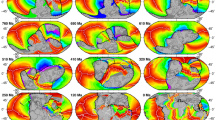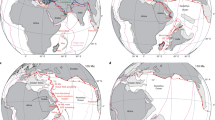Abstract
Mobile belts are long-lived deformation zones composed of an ensemble of crustal fragments, distributed over hundreds of kilometres inside continental convergent margins1,2. The Mediterranean represents a remarkable example of this tectonic setting3: the region hosts a diffuse boundary between the Nubia and Eurasia plates comprised of a mosaic of microplates that move and deform independently from the overall plate convergence4. Surface expressions of Mediterranean tectonics include deep, subsiding backarc basins, intraplate plateaux and uplifting orogenic belts. Although the kinematics of the area are now fairly well defined, the dynamical origins of many of these active features are controversial and usually attributed to crustal and lithospheric interactions. However, the effects of mantle convection, well established for continental interiors5,6,7, should be particularly relevant in a mobile belt, and modelling may constrain important parameters such as slab coherence and lithospheric strength. Here we compute global mantle flow on the basis of recent, high-resolution seismic tomography to investigate the role of buoyancy-driven and plate-motion-induced mantle circulation for the Mediterranean. We show that mantle flow provides an explanation for much of the observed dynamic topography and microplate motion in the region. More generally, vigorous small-scale convection in the uppermost mantle may also underpin other complex mobile belts such as the North American Cordillera or the Himalayan–Tibetan collision zone.
This is a preview of subscription content, access via your institution
Access options
Subscribe to this journal
Receive 51 print issues and online access
$199.00 per year
only $3.90 per issue
Buy this article
- Purchase on Springer Link
- Instant access to full article PDF
Prices may be subject to local taxes which are calculated during checkout




Similar content being viewed by others
References
Molnar, P. Continental tectonics in the aftermath of plate tectonics. Nature 335, 131–137 (1988)
Hyndman, R. D., Currie, C. A. & Mazzotti, S. Subduction zone backarcs, mobile belts, and orogenic heat. GSA Today 15 10:1130/1052–5173(2005)015 (2005)
McKenzie, D. P. Active tectonics of the Mediterranean region. Geophys. J. R. Astron. Soc. 30, 109–185 (1972)
Reilinger, R. et al. GPS constraints on continental deformation in the Africa-Arabia-Eurasia continental collision zone and implications for the dynamics of plate interactions. J. Geophys. Res. 111 B05411 10.1029/2005JB004051 (2006)
Lithgow-Bertelloni, C. & Silver, P. G. Dynamic topography, plate driving forces and the African superswell. Nature 395, 269–272 (1998)
Gurnis, M. Sculpting the earth from inside out. Sci. Am. 284, 40–47 (2001)
Daradich, A., Mitrovica, J. X., Pysklywec, R. N., Willet, S. D. & Forte, A. M. Mantle flow, dynamic topography, and rift-flank uplift of Arabia. Geology 31, 901–904 (2003)
Engdahl, E. R., van der Hilst, R. D. & Buland, R. Global teleseismic earthquake relocation with improved travel times and procedures for depth determination. Bull. Seismol. Soc. Am. 88, 722–743 (1998)
Wortel, M. J. R. & Spakman, W. Subduction and slab detachment in the Mediterranean-Carpathian region. Science 290, 1910–1917 (2000)
Piromallo, C. & Morelli, A. P-wave tomography of the mantle under the Alpine–Mediterranean area. J. Geophys. Res. 108 10.1029/2002JB001757 (2003)
Li, C., van der Hilst, R. D., Engdahl, E. R. & Burdick, S. A new global model for P wave speed variations in Earth's mantle. Geochem. Geophys. Geosyst. 9 Q05018 10.1029/2007GC001806 (2008)
Royden, L. H. Evolution of retreating subduction boundaries formed during continental collision. Tectonics 12, 629–638 (1993)
Gautier, P. et al. Timing, kinematics and cause of Aegean extension: a scenario based on a comparison with simple analogue experiments. Tectonophysics 315, 31–72 (1999)
Doglioni, C. A proposal for the kinematic modelling of the W-dipping subductions—possible applications to the Tyrrhenian-Apennines system. Terra Nova 4, 423–434 (1991)
DeMets, C., Gordon, R. G., Argus, D. F. & Stein, S. Effect of recent revisions to the geomagnetic reversal time scale on estimates of current plate motions. Geophys. Res. Lett. 21, 2191–2194 (1994)
Garfunkel, Z., Anderson, C. A. & Schubert, G. Mantle circulation and the lateral migration of subducted slabs. J. Geophys. Res. 91, 7205–7223 (1986)
Seber, D. et al. Crustal model for the Middle East and North Africa region: implications for the isostatic compensation mechanism. Geophys. J. Int. 147, 630–638 (2001)
Husson, L. Dynamic topography above retreating subduction zones. Geology 34, 741–744 (2006)
Sengor, A. M., Ozeren, C. S., Genç, T. & Zor, E. East Anatolia high plateau as a mantle supported, north–south shortened domal structure. Geophys. Res. Lett. 30, 8045–8049 (2003)
Ferranti, L. et al. Markers of the last interglacial sea level highstand along the coast of Italy: tectonic implications. Quat. Int. 145–146, 30–54 (2006)
Lustrino, M. & Wilson, M. The circum-Mediterranean anorogenic Cenozoic igneous province. Earth Sci. Rev. 81, 1–65 (2007)
D'Agostino, N. & McKenzie, D. Convective support of long wavelength topography in the Apennines (Italy). Terra Nova 11, 234–238 (1999)
Shaw, M. & Pysklywec, R. Anomalous uplift of the Apennines and subsidence of the Adriatic: The result of active mantle flow? Geophys. Res. Lett. 34 L04311 10.1029/2006GL028337 (2007)
Serpelloni, E. et al. Kinematics of the Western Africa–Eurasia plate boundary from focal mechanisms and GPS data. Geophys. J. Int. 169, 1180–1200 (2007)
D'Agostino, N. et al. Active tectonics of the Adriatic region from GPS and earthquake slip vectors. J. Geophys. Res. 113 B12413 10.1029/2008JB005860 (2008)
Casas-Sainz, A. M. & de Vicente, G. On the tectonic origin of Iberian topography. Tectonophysics 474, 214–235 (2009)
Lucente, F. P., Margheriti, L., Piromallo, C. & Barruol, G. Seismic anisotropy reveals the long route of the slab through the western-central Mediterranean mantle. Earth Planet. Sci. Lett. 241, 517–529 (2006)
Zhong, S., Zuber, M. T., Moresi, L. & Gurnis, M. Role of temperature-dependent viscosity and surface plates in spherical shell models of mantle convection. J. Geophys. Res. 105, 11063–11082 (2000)
Simmons, N. A., Forte, A. M. & Grand, S. P. Joint seismic, geodynamic and mineral physical constraints on three-dimensional mantle heterogeneity: Implications for the relative importance of thermal versus compositional heterogeneity. Geophys. J. Int. 177, 1284–1304 (2009)
Bassin, C., Laske, G. & Masters, G. The current limits of resolution for surface wave tomography in North America. Eos 81, abstr. F897 (2000)
Acknowledgements
C.F. thanks the University of Southern California (USC) and the Consiglio Nazionale Ricerche for supporting his visit at USC. This work has been financially supported by TOPOEUROPE and MEDUSA (NSF-EAR 0451952), computations were performed on USC’s High Performance Computing Center, and we thank the Computational Infrastructure for Geodynamics and the seismologists who shared their tomographic models in electronic form. C.F. thanks R. Funiciello for his support and suggestions.
Author information
Authors and Affiliations
Contributions
T.W.B. performed numerical modelling, C.F. designed the modelling strategy. Both authors contributed equally to interpreting and analysing the data and to writing the paper.
Corresponding author
Ethics declarations
Competing interests
The authors declare no competing financial interests.
Supplementary information
Supplementary Information
This file contains Supplementary Information, References, and Supplementary Figures S1-S4 with legends. (PDF 5574 kb)
Rights and permissions
About this article
Cite this article
Faccenna, C., Becker, T. Shaping mobile belts by small-scale convection. Nature 465, 602–605 (2010). https://doi.org/10.1038/nature09064
Received:
Accepted:
Issue Date:
DOI: https://doi.org/10.1038/nature09064
Comments
By submitting a comment you agree to abide by our Terms and Community Guidelines. If you find something abusive or that does not comply with our terms or guidelines please flag it as inappropriate.



